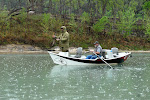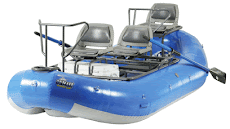
One of the best pieces of advise I can give you is, get a copy of “Fly Fishing the Tailwaters” by Ed Engle, Stackpole Books. Most of the comments made here are echoed in Ed’s Book. I sometimes refer to it, as the instruction manual for the Guadalupe Tailrace.
Rivers below dams are referred to as tailwaters or tailraces. The controlled release of water from a reservoir into the river below often moderates extreme flows from the upper river in times heavy rains, provides for increased water flow during dry periods, clears the water, and provides higher levels of nutrients. This makes for great Trout habitat year round.
The exception on the Guadalupe River is, several diversion dams are scattered throughout the first 13 miles of the tailrace. In the summer months when the temps reach into the high 90’s, what is normally, a great holding spot for feeding trout becomes much less likely to hold Trout. A diversion dam in the summer months has the warmest water flowing over the top of the dam which means the water below will have elevated temperatures. Trout will move further down stream to the cooler water.
Wading is a little more slippery in a tailwater, especially below water-storage reservoirs. The reason is not only does a more uniform flow created by the water release encourage the growth of algae and other aquatic vegetation which is clearer because of the regular flow and the added light that is available for photosynthesis. In addition, the water is drawn from the bottom layers of the reservoir tends to be rich with nutrients from organic debris that are on the floor of the reservoir bottom. The Guadalupe has been consistently around 200 cfs since June so the consistent flows have made it unusually slippery.
A few of the insects you will find in the Guadalupe Tailrace are common in other tailrace fisheries. BWO Blue Wing Olives , PMDs Pale Morning Duns, Caddis, Tricos are the prevalent insects.
Although, many trout are taken on dry fly imitations of the insects mentioned above, trout spend anywhere from 80-90 percent of their time feeding below the surface on the immature forms of aquatic insects. The point here is don't forget the nymph and midge box when you fish the Guadalupe Tailrace!
I've been fishing the "Guad" for 15 plus years and full time for the last 9 years. What I've found to be the most productive method for trout is nymphing. I use a dropper set up with an indicator. It consist of an indicator placed about 11/2 - 2 times the depth of the water. In other words, if you are fishing 3' depth of water, your indicator should be about 51/2'- 6' up the leader from the top fly. If you are using a spit shot it should be from the split shot, which is placed about 4"-6" above the first fly. The top fly is used as an attractor, something to get their attention. Normally I use a #14-16 for the top fly. The dropper fly is much smaller, #18-22. This fly is what I call trout candy. You would be amazed at the number 18"- 26" trout are caught on a #22 size fly.
If your not getting hook-ups go deeper. Add weight until you finally hit bottom, then back off a little. I think, one of the reasons trout eat sub-surface food 80-90% of the time is, they are more likely to take food below them than above. Change flies often, this is hard to do, but if they don't take it in ten casts, the odds are they won't ever.
Line control is a must. You will hear that you must have a dead-drift to be effective. You want a controlled drift, not always a dead drift. Sometimes you want to agitate your nymphs. If your in a slow moving section of the river, a lot of times giving the nymphs some action helps the fishing. If you think about it, lots of fish are caught on the swing, the end of the drift when the fly begins to get down stream tension bringing the flies off the bottom, enticing a strike. It is the movement of the fly that entices the strike.
Where trout hold on the "Guad". Trout hold and feed on the edges of horizontal columns of water. What I mean by this is, you may have as many as three columns of water moving at different velocities. The water may be moving at a higher velocity (moving faster) 4' from your position, and a slower column 8' from your position. And then fast again 12' from your position. This can be caused by the dept of the water, a pocket of slow moving water behind a rock. There are many different things that can effect the flow of water but if you focus on the water you can see the different columns of velocity. Trout are lazy and big trout are lazier, so you will find them on the edge of a faster moving column laying in the slower moving column, where they can move out into faster column, where the food will be drifting, and then back to the slower water, where they do not have to expend as much energy. Watch for bubble lines, this is usually where the most food is in the drift.
Last but not least, Catch and Release. Land your fish as quickly as possible. If you must take a picture, wet your hands, handle gently, don't squeeze the fish. Take a deep breath, and hold it, if you have to exhale, you've had the fish out of the water to long. An option to photograph the fish is, move to the bank or very shallow water while landing the fish and then take your photo with the fish in the water next to your foot. I must warn you, you cannot exaggerate the size if it's next to your foot. You can also remove the fly without ever taking the fish out of the water.
One last thing, River Etiquette. It is just common sense. Never wade or float into another anglers vicinity, never crowd, even if he's catching one on every cast. Ask if you can float around or give him a wide berth when wading around. Move at least 100', let me repeat that 100', let me repeat that one more time 100', above or below him/her before fishing. It is not that far. 10 basketball goals. If you are the angler catching the fish, net 4-5 fish and then move on and let someone else have a shot. Even if no other angler is waiting, or around, net a few fish and move on. If you use the Tips & Tricks above, you'll hook up on more fish at different locations. The idea is to fish the stream not a hole. You will learn much more by fishing lots of habitat.
Bill Higdon

















